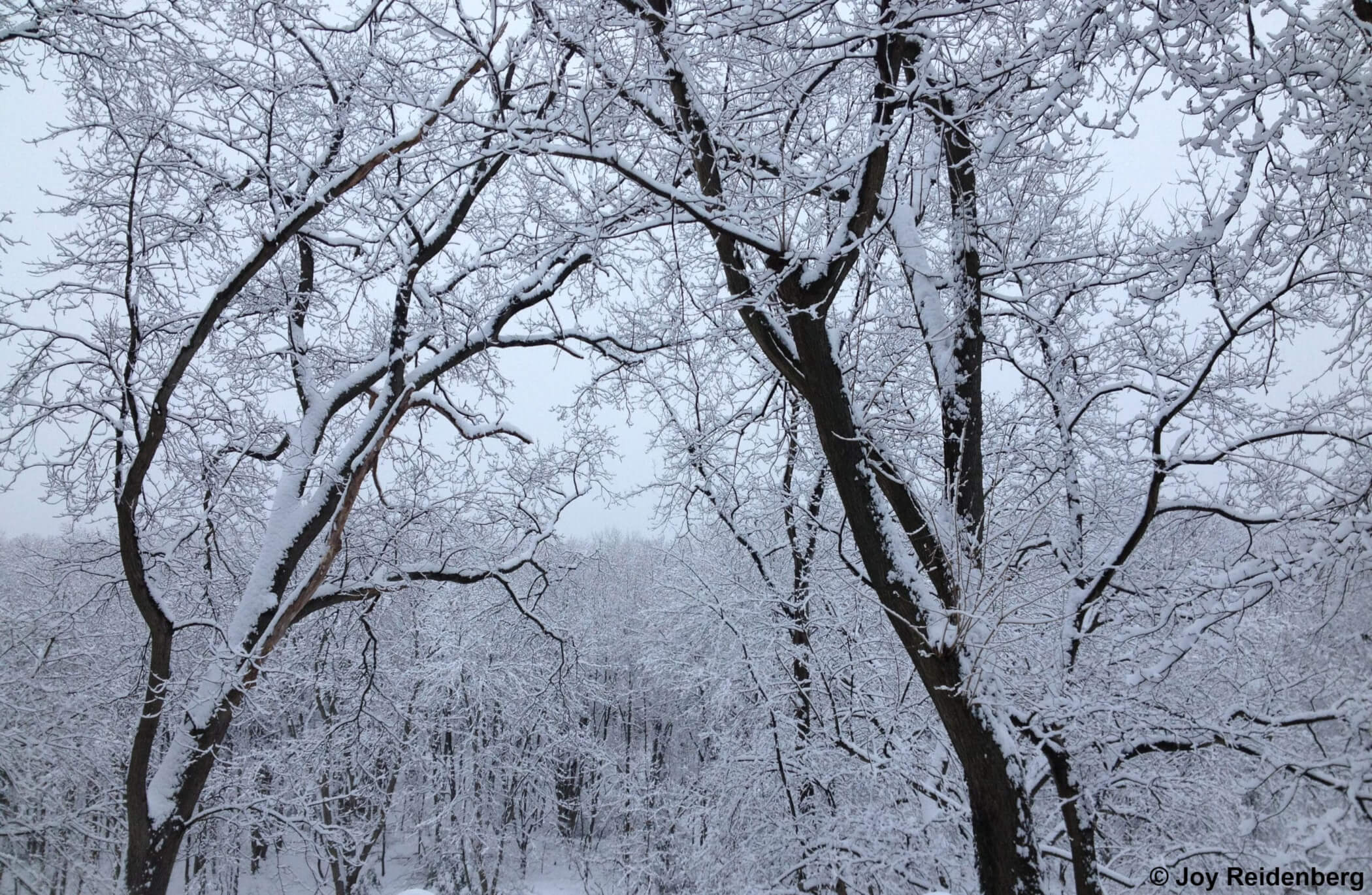Survival Adaptations
By: Michael Gambino / Curator / Edith G. Read Wildlife Sanctuary
February 23, 2016
Most people don’t think about trees having to survive the winter. That’s probably because we see the same trees year after year and they tend to look pretty much the same. They are always there, silent and uncomplaining through heat and sleet and gloom of night. They are not furry, comical, or cute. They do not demonstrate athletic or predatory prowess as do the animals great and small that we admire, so it’s easy to forget about the trees in our lives. Yet they are every bit as amazing, inspiring, and tough as other life forms on earth. Just as with our furred, finned, and feathered brothers and sisters, trees have been “tested” by evolutionary fires, and their strategies for survival – their adaptations – are pure and proven genius.
If a species cannot adapt, or adapt quickly enough, it may eventually fade away, or only exist in small pockets where conditions are favorable. Natural selection is a very long process of trial and error and adjustment, and it is at work in every organism you see, every day, from hedgehogs to humans and from ticks to trees. Repeated challenges to the integrity of an organism can stimulate small sometimes useful changes in its genome (these are called “beneficial mutations”) that help counter whatever the threat may be.
You may not think that trees have to “survive” anything except fire and hurricanes or tornadoes. Well, consider the main threats from the winter’s cold embrace: freezing temperatures, dehydration, and physical damage from winter storms. These threats apply to all organisms in the regions where winters are harsh. Freezing temperatures and dehydration can also damage or kill trees in winter. When liquid water freezes, the water molecules form ice crystals. No harm done if you want to drop some ice cubes into your beverage or go skating on a frozen pond. However, if the freezing water molecules are contained inside the cells of your fingers and toes, as in frostbite, the ice crystals form and expand, acting like microscopic daggers, piercing cell membranes and killing them. Tree sap is about 95% water, and some individuals have millions of gallons of sap flowing up and down the trunk and out to the tips of every leaf and twig*. Since trees cannot migrate to avoid winter (what a sight THAT would be), they have adaptations that allow them to reduce the chance that winter might kill or damage them.
*Trees maintain an uninterrupted column of water in small hollow tubes (called xylem) by the use of root pressure, capillary action, and the cohesive nature of water molecules.
Leaf Drop
The most noticeable winter survival adaptation for broad-leaved trees is the autumn leaf drop. Leaves add a lot of mass and wind resistance to a tree, and this would be a liability for the tree in snow and ice storms, especially if high winds also occur as with a nor’easter or a blizzard. Leaves would also add more surface area for cold dry winds to suck the moisture from the tree by evaporation.
During the warm growing season, water vapor is released along with oxygen from the pores or stomata on each leaf in the process of photosynthesis. The process of transpiration is what helps transport water and nutrients in the sap through the tree all the way to the leaves. All the water in the tree is connected by touch, so as water evaporates from the leaves, more water is drawn upward to replace water lost to the wind and sun.
Trees prepare for winter by sealing off this water vapor loss by forming an abscission layer of cells at the base of each leaf stem. Once this is done the leaves fall away. This adaptation conserves precious water reserves in the tree during winter months when liquid water is not always available, thus avoiding the danger of dehydration. Most of their sap is stored in their root system deep underground out of reach of winter’s icy grip. The small amount of sap that remains in the above ground portion of the tree has a higher concentration of sugar. This sugar acts as an anti-freeze of sorts and works by lowering the freezing point of the water.
Dropping their broad leaves also lessens the available surface area that would accumulate tons of snow and ice build-up during winter storms that could lead to broken limbs.
The farther north you go, tree species are primarily or exclusively evergreens. Trees such as White Pine, Norway Spruce, Red Cedar, Balsam Fir, and Eastern Hemlock have a greater tolerance for dry, sub-freezing conditions. They do not need to drop all their leaves (needles) before winter because they possess several special adaptations. Maintaining functioning leaves year-round (photosynthesis) is an advantage in regions with a very short summer season and dim winter sunlight. The sap of evergreen trees is a sticky, viscous, resinous sap that won’t freeze and expand like the sap of deciduous trees. Also the leaves themselves are much smaller and so have less surface area to lose moisture from. In addition, the leaves have a waxy coating that protects against vapor loss. The shape of evergreen trees is such that the branches shed accumulating snow with ease, gradually bending without breaking under the weight of all those snowflakes until gravity does the rest.
Bark
Another adaptation trees have to help them survive winter is their bark. In nature, nothing is pointless or arbitrary. So it is with the variations in bark coloring texture and density. Light-colored, smooth-barked trees such as the grey American Beech and the bright white Paper Birch (Betula payrifera), contrast with the very dark colored rough-textured bark of trees like Black Cherry and White Pine. Most other broad-leaved trees in our northeastern forests tend towards the darker end of the color spectrum, and have scaly or deeply furrowed bark.
In winter, the bark’s main purpose is to protect the tree from freezing and cracking during severe cold spells. However, the bark is not directly protecting the tree from cold, but rather from the heat of the sun. It is not necessarily the sap that freezes which causes a tree to crack, but rather the differential heating and cooling of the tree from inside to outside. In other words, when the tree is exposed to the warmth of the sun, the interior and exterior of the tree heats up and expands. However, at night when the bark is exposed to cold winds it can cool and contract much more rapidly than the interior of the tree does. This can result in the splitting of the protective bark layer because the circumference of the outer layer of the tree becomes smaller than the warmer, still expanded interior circumference of the tree.
I recall one winter when I was a young boy visiting relatives in upstate New York. It was around Christmas time and the temperatures plummeted sharply. By the time nightfall came, the already low temperatures became severe. My siblings and cousins and I bundled up in nearly every bit of winter clothing we owned and ventured down the country road to see what 50 degrees below zero felt like. The wind howled across the landscape while the silent stars gleamed overhead. My eyes teared from the cold, biting wind and these tears froze on my eyelashes. Suddenly we heard the violent sound of trees “exploding” throughout the woods. It was terrifying! A falling tree or dropped limb sounds nothing like a large tree whose trunk is shattered by the cold.
The bark protects the tree against this danger in several ways. By having a reflective quality like the light gray or bright white coloring, the bark doesn’t warm up much during the daylight hours, thus minimizing the temperature difference from interior to exterior of the tree. So what about dark tree bark then? While the dark, almost black coloring of bark will definitely warm up faster than white bark, it also sheds accumulated heat faster**. The deeply furrowed or scaled bark on dark-colored trees also acts like a radiator to diffuse heat before it can warm the interior of the tree (which causes the expansion). In Canada and Northern New England where Paper Birch grows the daylight hours are noticeably shorter, and sunlight is weaker in winter months than at lower-latitudes. Here, the light-colored bark is less likely to accumulate much heat in the first place.
If you look closely at most trees with curly, furrowed, or scaly bark you’ll see that the bark is also made of many thinner layers that expand or contract with heat, cold, and moisture. When the bark absorbs moisture, it acts as an impact attenuator minimizing damage from any nearby falling trees and limbs during rain, snow, and ice storms. If you have ever tried to use an axe on a rain-soaked log, you’ll know how effective this adaptation can be. Often the axe simply bounces off the log.
Trees are magnificent in their form, function, and beauty. Next time that you walk the trails of the sanctuary, or even just around your neighborhood, why not stop for a while and have a good long look at a tree. Feel its presence as a living, breathing organism that, like you, must deal with stresses of daily life and have enough food and water to live. Take a moment to offer your heartfelt gratitude for all that trees have given you, from the oxygen in your red blood cells to the lumber that makes up the shelter that you call home.
* *This is why the Space Shuttle has black tiles on the bottom of the craft to aid in shedding the massive heat build-up from re-entry friction once entering the cold upper atmosphere.

